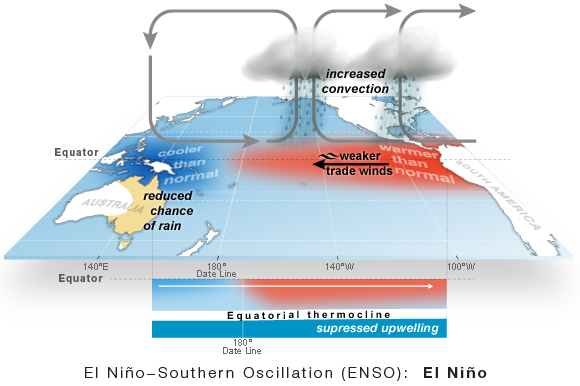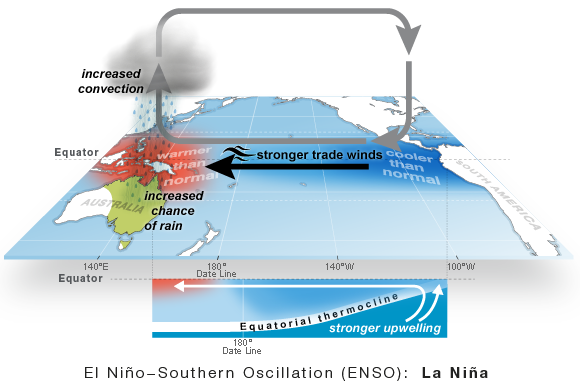El Niño and La Niña are the two extreme phases of the El Niño Southern Oscillation (ENSO) that develops in the tropical Pacific Ocean. ENSO is an irregularly periodic variation in winds and sea surface temperatures. El Niño is the warmer phase while La Niña is the colder phase of the ENSO cycle. Both these phenomena severely impact the global weather climate and are diagonally opposite to each other in terms of features. Below we are presenting major differences El Niño and La Niña in a tabular form.
| Basis of Comparison | El Niño | La Niña |
|---|---|---|
| Diagram |  |
 |
| Terminology | The term “El Niño” has a Spanish origin and it means “the little boy” or “Christ child”. | The term “La Niña” too has a Spanish origin and it means “the little girl”. |
| Ocean Temperature | Warm ocean temperature in equatorial Pacific. | Cold ocean temperature in equatorial Pacific. |
| Seasonal Cycle | Linked with the weakening of the seasonal cycle. | Linked with the exaggeration of the seasonal cycle. |
| Air Surface Pressure | Brings along high air surface pressure on the western side of the Pacific Ocean. | Brings along low air surface pressure on the eastern side of the Pacific Ocean. |
| Trade Winds | Westward blowing trade winds weaken during the El-Niño phase. Changes in wind speed and air pressure cause the warm surface water to move in an eastward direction along the equator. Thus, the wind blows from the western Pacific towards the South American coast. | Easterly trade winds get even stronger during the La Niña phase. Strong easterly trade winds push the ocean surface water towards the western Pacific and much cooler water from the deep is drawn up in the Eastern Pacific. |
| Coriolis Force | Strength of Coriolis Force declines | Strength of Coriolis Force increases. |
| Upwelling | El Niño witnesses reduced upwelling as the warm water approaches the eastern Pacific(South American coast). This leads to a direct reduction in the fish population due to a significant decrease in nutrient-rich deep ocean water. | During La Niña, the cooler nutrient-rich water is found in the eastern Pacific region. This witness a significant increase in the fish population. |
| Tropical Cyclones | During El Niño, the wind speed is much lower so it suppresses the formation of tropical cyclones. This is the reason why weaker and lesser numbers of tropical cyclones are formed. | La Niña experiences frequent and much stronger tropical cyclones especially in the north Indian ocean region. Winds from Africa and beyond get blocked and the winds direction changes pilling up water between Indonesia and close-by regions. This eventually leads to the formation of intense cyclones. |
| Season |
|
|
| Impact |
|
Use the citation below to add this article to your bibliography
"El Niño vs. La Niña: Differences and Impact on Weather and Rainfall." Dashamlav.com. Web. 13 June 2025. <https://dashamlav.com/el-nino-vs-la-nina-impact-weather-rainfall/>
Dashamlav.com, "El Niño vs. La Niña: Differences and Impact on Weather and Rainfall." Accessed 13 June 2025. https://dashamlav.com/el-nino-vs-la-nina-impact-weather-rainfall/
"El Niño vs. La Niña: Differences and Impact on Weather and Rainfall." (n.d.). Dashamlav.com. Retrieved 13 June 2025 from https://dashamlav.com/el-nino-vs-la-nina-impact-weather-rainfall/
